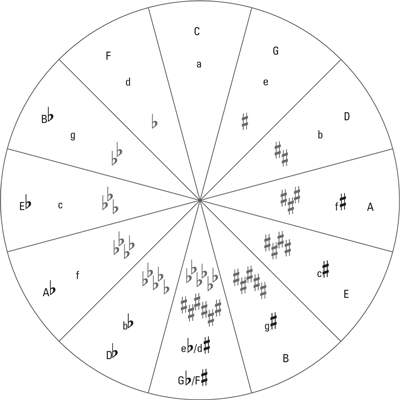Music composition is a detailed activity that requires knowledge of a whole range of music basics: how to make use of the Circle of Fifths; knowing which major and minor chord progressions are most pleasing to the ear; and determining the Greek scale that's best suited to your piece. Plus, need to have an ear for musical forms and have the technical skill to transpose music for different instruments.
>
>
Composing Music and the Circle of Fifths
If you're into music composition, you need to know the Circle of Fifths because it shows the relationships between major keys and their relative minors. In the following image, the major keys are indicated with capital letters, and their relative minors are in lowercase. Also shown are the number of sharps or flats that you put in the key signature for each key.

>
>
>
Musical Forms for Music Composition
In composing music, you follow certain rhythm forms. These musical forms outline placement for accented and unaccented beats that form a pattern for a passage or for a whole piece. The following list offers a handy guide to the different parts in different types of compositions:
One part form: A, AA, AAA, and so on
Binary form: AB, AABB
Ternary/tertiary form: ABA, AABA
Arch form: ABCBA
Sonata: ABA
Rondo: ABACADAEAF
8-bar blues: I, IV, I, VI, ii, V, I, V/I (turnaround)
12-bar blues: I, I, I, I, IV, IV, I, I, V, IV, I, V/I (turnaround)
16-bar blues: I, I, I, I, IV, IV, I, I, V, IV, V, IV, V, IV, I, V/I (turnaround)
24-bar blues: 8xI, 4xIV, Ix4, V, V, IV, IV, I, I, I, V/I (turnaround)
Verse-chorus form (pop music): Intro ABACBCB
>
>
>
Seven Greek Modes for Music Composition
If you're composing music, you generally use one of the seven main types of musical scales, or modes, generally referred to as Greek scales. Each one consists of eight notes, combining whole and half steps in slightly different combinations to produce different feelings in the listener. The following list shows these Greek scales:
Ionian (the major scale): W(hole step), W, H(alf step), W, W, W, H
Dorian: W, H, W, W, W, H, W
Phrygian: H, W, W, W, H, W, W
Lydian: W, W, W, H, W, W, H
Mixolydian: W, W, H, W, W, H, W
Aeolian (the minor scale): W, H, W, W, H, W, W
Locrian: H, W, W, H, W, W, W
>
>
>
Major and Minor Chord Progressions for Music Composition
As you compose music, you quickly realize that some chords just sound right together, and some don't. The following is a list of the tried-and-true major chord sequences that always sound good when played together:
I chords can appear anywhere in a progression
ii chords lead to I, V, or vii° chords
iii chords lead to I, ii, IV, or vi chords
IV chords lead to I, ii, iii, V, or vii° chords
V chords lead to I or vi chords
vi chords lead to I, ii, iii, IV, or V chords
vii° chords lead to I or iii chords
The minor chords that form good-sounding progressions echo those of the major chords, as shown in the following list:
i chords can appear anywhere in a progression
ii° or ii chords lead to i, iii, V, v, vii°, or VII chords
III or III+ chords lead to i, iv, IV, VI, #vi°, vii°, or VI chords
iv or IV chords lead to i, V, v, vii°, or VII chords
V or v chords lead to i, VI or #vi° chords
VI or #vi° chords lead to i, III, III+, iv, IV, V, v, vii°, or VII chords
vii° or VII chords lead to i chord
>
>
>
Rules of Transposition for Music Composition
If you're composing music for more than one instrument, you know that writing for transposing instruments can get confusing. The following list offers some easy ways to approach each kind:
E flat instruments: Find the relative minor, make it major, and then write in that key. Notes are therefore moved up a sixth, or down a minor third.
F instruments: Just add one sharp or subtract a flat from the key signature and write the music in the resulting key. Therefore, notation is moved up one perfect fifth from where originally written.
B flat instruments: Move everything up one whole tone. E flat becomes F, F becomes G, and so on.
>
>
dummies
Source:http://www.dummies.com/how-to/content/music-composition-for-dummies-cheat-sheet.html
No comments:
Post a Comment